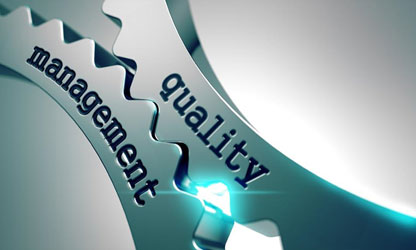July 29, 2019
Quality management involves keeping many wheels turning at once. To achieve a consistent state of high-quality production, quality management has to combine numerous key components and processes into one whole. Obviously, it’s not easy. So, what’s the secret to success of the best quality management programs in the manufacturing world?
One aspect that many highly successful quality management programs have in common is that they’ve learned how to avoid the usual pitfalls. These eight quality management issues crop up again and again in quality management programs. Learn them, analyze them and figure out how your organization can avoid them.

It’s true that in some ways, quality management is a reactive process—you look at the data to find where improvements are needed and make adjustments accordingly. But what distinguishes a truly effective program is a focus on proactive measures that help create better processes in the first place, such as:
By looking at how to make improvements before problems manifest, you can change your program’s mindset from “how to not lose” to “how to win and keep winning.”
Quality management rarely works as it should when it’s not integrated throughout an organization. Thus, your systems should be built with collaboration and communication in mind. Wherever possible, ensure that your quality management programs are conducted via common channels that facilitate transparency and cooperation between departments, and integrate disparate applications on common platforms that allow easy access to relevant data. Take a look at the basic principles of breaking down silos to get some more ideas on how to build integrated quality management processes.
You’ve heard the old rule of “look before you leap,” and it’s a great one to apply to quality management practices. Remember that a Non-Conforming Materials Report isn’t and shouldn’t be the same as a Corrective Action Request. The first identifies the problem, while the second details what actions need to be taken to fix it. In between the two, it’s essential to put manufacturing problems under a microscope to conduct a data-driven analysis that gets to the root of the problem. Only once you fully understand it will you have the ability to create a lasting fix.
No matter how well-designed your quality management programs are, they won’t go far without support from leadership. Upper management is responsible for steering an organization’s goals and culture, and if those don’t include a commitment to quality improvement, employees are unlikely to put in the required effort. If your leadership isn’t supporting quality management efforts or, even worse, pushing in the wrong direction, it’s time to have a conversation about how they can help overcome barriers to change.

Data is the lifeblood of a quality management program. But you’d be surprised how many organizations rely on outdated data storage and management methods. Legacy IT systems can be a big obstacle, as their flexibility and interoperability typically can’t match newer cloud-based systems. And if you’re still exclusively using pen and paper records, it should go without saying that you’re handicapping your quality management. Investigate your options for getting your quality management data on an integrated cloud-based platform that allows you to correlate manufacturing, logistics, sales and CRM.
Fear of punishment can be used to motivate employees to improve quality metrics, but it’s extremely risky due to its potential to backfire. Research shows that motivating employees through fear has major disadvantages, including:
Rather than motivating through fear, offer praise, clear guidance, constructive criticism and, perhaps most importantly, a solid explanation of why quality management changes are necessary. Not only will it create more efficient quality programs, but it will also improve your organization’s general work environment.
To gather the data you need, it’s crucial to have equipment that’s up to the task. Food processing manufacturers, for example, should be sure that they’re using the latest in microscope technology to identify possible microbial threats. Manufacturers of all kinds should also investigate the data gathering and quality management possibilities offered by Internet of Things devices, including:
Customer feedback offers a key input for quality management. Thus, when you’re designing your processes, it can be tempting to release a long, complex customer survey to get as many data points as possible. The problem is that this can easily backfire by preventing customers from taking your surveys in the first place. Instead, focus on best practices of customer survey design and isolate the most critical data points. You can design new surveys to focus on different problems after you’ve addressed the issues at hand.

With global supply chains and regulatory climates that change frequently, the challenges of quality management have only become more complex. However, with careful attention to detail and a working knowledge of how to avoid common mistakes, your business can design quality management processes that are genuinely helpful in creating better products and a stronger business.

Cheryl Stevens
Cheryl Stevens is the Community Relations Specialist for AmScope. She oversees all company-wide outreach programs and initiatives. Her passion in life is helping others see the value of and implement STEM programs for children at an early age.
E: content@unitedschope.com
P: 888-950-2888
In this episode, I sat down with Beejan Giga, Director | Partner and Caleb Emerson, Senior Results Manager at Carpedia International. We discussed the insights behind their recent Industry Today article, “Thinking Three Moves Ahead” and together we explored how manufacturers can plan more strategically, align with their suppliers, and build the operational discipline needed to support intentional, sustainable growth. It was a conversation packed with practical perspectives on navigating a fast-changing industry landscape.